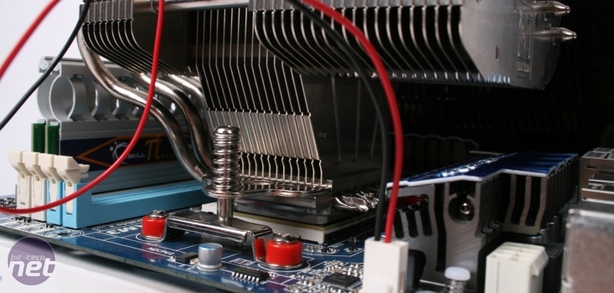Overclocking
Given AMD's claims of huge overclocks we wanted to see if we could push our chip beyond 4GHz, and started our testing there. We know plenty about the Gigabyte GA-MA790FXT-UD5P so we set that up for a big HTT by upping the SB/HT and the CPU NB by +0.2V, and applied 1.9V to our G.Skill DDR3 memory.First off, we tried a a vcore of 1.55V (+0.15V) and a combination of a 15x multiplier and a HTT of 270MHz for a 4.05GHz CPU. We know the Gigabyte board can handle such a high HTT but the CPU flaked out almost as soon as we entered Windows. Taking a trip back into the BIOS, we upped the CPU voltage to 1.6V, but to no avail, and 1.65V didn't help either.
We therefore had to step down the overclock, using a vcore of 1.55V, a 15x multiplier and a HTT of 260, for a 3.9GHz overclock. This didn't work either. Dropping the HTT to 255MHz (for a 3.83GHz overclock) didn't work. Exasperated, we went very conservative, thinking that maybe the CPU just needs a bit of warming up first.
We therefore lowered the vcore to 1.5V (+0.1V) and used a multiplier fo 16 with a HTT of 240MHz to give us a 3.84GHz CPU. This worked fine, priming away for ages stably. The CPU was fine at 3.92GHz (16x245) too, but 4GHz was too much and we were jolted back into BSODland. Adding more voltage didn't help things, with the BSOD occurring earlier when we used a vcore of 1.55V or 1.6V than 1.5V. So much for AMD's claim that the 965 BE is more tolerant of extra voltage - it looks like you'll need to either get lucky with a low-vid chip or else break out the water-cooling in order to get it over 4GHz.
Just to re-cap then, our final highest overclock was 3.92GHz, achieved with a multiplier of 16 and a HTT of 245MHz. We upped the CPU NB and HTT Link to 10x to give us 2,450MHz buses rather than the poxy default 2,000MHz ones. The system refused to run with either bus overclocked by any more, as we've seen that 2,600MHz is really all you should expect. Unfortunately, the memory dividers of the Gigabyte meant we had to run our DDR3 at 1,306MHz as the next strap up would've pushed our memory out of spec.
We've included the Intel Core 2 Quad Q9650 in this review as we felt this is the most comparable CPU despite it being roughly £40 more expensive. Have a flick through the graphs, and you'll see that the 965 BE holds its own nevertheless. To overclock the Q9650 from its stock speed of 3GHz to 4.01GHz we used a vcore of 1.45V and an FSB of 445MHz with the default 9x multiplier.
WPrime
Download from: www.wprime.netWPrime is a multi-threaded maths calculation benchmark that counter-intuitively uses square roots rather than prime numbers. The standard benchmark uses 32 million numbers, calculating the square root via 'a recursive call of Newton's method for estimating functions'. We're not sure what that means either, but you can read the full blurb on WPrime's About page. What we do know is that WPrime scales well across multiple CPU cores, and can push a CPU to 100 per cent load on all its cores.
To run the benchmark, first visit the core count to check that WPrime will load all physical and logical cores, and then run the 32M test. The results are expressed as a time taken to calculate the square root of the set of numbers (32 million in the standard test). A lower score is better.
For analysis of these results, please read the Results Analysis page.

MSI MPG Velox 100R Chassis Review
October 14 2021 | 15:04












Want to comment? Please log in.